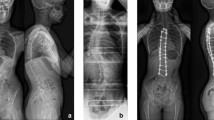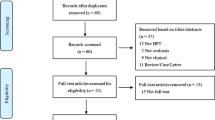Abstract
Background
There have been no standardized surgical options for severe scoliotic curvatures ≥100°. Halo-gravity traction is a viable option for surgical treatment of severe scoliosis. The aim of this study was to evaluate the efficacy and safety of perioperative halo-gravity traction for scoliosis curves ≥100° with respect to radiographic outcomes and clinical complications.
Methods
A total of 21 scoliosis patients with ≥100° curves (average 118.7°; range 100°-158°) with a minimum 2-year follow-up (average 41.8 months; range 24.0-97.0 months) who underwent spinal instrumented fusion using perioperative halo-gravity traction were analyzed. Diagnoses were neuromuscular scoliosis (n = 10), idiopathic (n = 9), and congenital (n = 2). In all, 15 patients were treated by the anterior release procedure followed by final posterior fusion and 6 patients by posterior fusion alone. Six patients had only preoperative traction preceding posterior fusion alone, 6 patients only staged traction between anterior release and final posterior fusion, and 9 patients had both preoperative traction preceding anterior release and staged traction preceding final posterior fusion. The average overall traction period in all patients was 67 days (range 10–78 days).
Results
Radiographic outcomes demonstrated 51.3% correction of the major Cobb angle, 40 mm correction of apical vertebral translation, 76 mm increase of T1-S1 length, and 20.7% increase of space available for lungs at the ultimate follow-up (all comparisons P < 0.05). Preoperative traction demonstrated 27.5% correction of the major curve Cobb angle, 51.5 mm increase of T1-S1 length, 14.9% increase of space available for the lungs (all comparisons P < 0.05). Staged traction after anterior release demonstrated 37.2% correction of the major curve Cobb angle, 26.1 mm correction of apical vertebral translation, 56.5 mm increase of T1-S1 length, 14.2% increase of space available for the lungs (all comparisons P < 0.05). There were only two patients with a pin-site problem, and one required débridement. There were no neurological deficits or clinical complications.
Conclusions
Scoliosis patients with ≥100° curves can be managed successfully by corrective fusion surgery concomitant with perioperative halo-gravity traction without significant complications.
Similar content being viewed by others
References
Stagnara P. [Cranial traction using the “Halo” of Rancho Los Amigos.] Rev Chir Orthop Reparatrice Appar Mot 1971;57:287–300 (in French)
Takeshita K, Lenke LG, Bridwell KH, Kim YJ, Sides B, Hensley M. Analysis of patients with nonambulatory neuromuscular scoliosis surgically treated to the pelvis with intraoperative halofemoral traction. Spine 2006;31:2381–2385.
Lenke LG, Bridwell KH, Blanke K, Baldus C. Analysis of pulmonary function and chest cage dimension changes after thoracoplasty in idiopathic scoliosis. Spine 1995;20:1343–1350.
Campbell RM Jr, Smith MD, Mayes TC, Mangos JA, Willey-Courand DB, Kose N, et al. The characteristics of thoracic insufficiency syndrome associated with fused ribs and congenital scoliosis. J Bone Joint Surg Am 2003;85:399–408.
Dewald RL, Ray RD. Skeletal traction for the treatment of severe scoliosis: the University of Illinois halo-hoop apparatus. J Bone Joint Surg Am 1970;52:233–238.
Ginsburg GM, Bassett GS. Hypoglossal nerve injury caused by halo-suspension traction: a case report. Spine 1998;23:1490–1493.
Wilkins C, MacEwen GD. Cranial nerve injury from halo traction. Clin Orthop 1977;126:106–110.
MacEwen GD, Bunnell WP, Sriram K. Acute neurological complications in the treatment of scoliosis: a report of the Scoliosis Research Society. J Bone Joint Surg Am 1975;57:404–408.
Dove J, Hsu LC, Yau AC. The cervical spine after halo-pelvic traction: an analysis of the complications of 83 patients. J Bone Joint Surg Br 1980;62:158–161.
Kalamchi A, Yau AC, O’Brien JP, Hodgson AR. Halo-pelvic distraction apparatus: an analysis of one hundred and fifty consecutive patients. J Bone Joint Surg Am 1976;58:1119–1125.
Ransford AO, Manning CW. Complications of halo-pelvic distraction for scoliosis. J Bone Joint Surg Br 1975;57:131–137.
Tredwell SJ, O’Brien JP. Apophyseal joint degeneration in the cervical spine following halo-pelvic distraction. Spine 1980;5:497–501.
Abu Salim F, Zielke K. [Osteoporosis and halo traction in scoliosis patients (author’s translation).] Z Orthop Ihre Grenzgeb 1982;120:330–332 (in German).
Sink EL, Karol LA, Sanders J, Birch JG, Johnston CE, Herring JA. Efficacy of perioperative halo-gravity traction in the treatment of severe scoliosis in children. J Pediatr Orthop 2001;21:519–524.
Rinella A, Lenke L, Whitaker C, Kim Y, Park SS, Peelle M, et al. Perioperative halo-gravity traction in the treatment of severe scoliosis and kyphosis. Spine 2005;30:475–482.
O’Brien JP. The management of severe spinal deformities with the halo-pelvic apparatus; pitfalls and guidelines in its use. (Proceedings and Reports of Universities, Colleges, Councils and Associations). J Bone Joint Surg Br 1977;59:117–118.
Garfin SR, Botte MJ, Waters RL, Nickel VL. Complications in the use of halo fixation device. J Bone Joint Surg Am 1986;68:320–325.
Goodman ML, Nelson PB. Brain abscess complicating the use of a halo orthosis. Neurosurgery 1987;20:27–30.
Letts RM, Palakar G, Bobecko WP. Preoperative skeletal traction in scoliosis. J Bone Joint Surg Am 1975;57:616–619.
Bang-ping Q, Yong Q, Bin W, Yang Y, Ze-zhang Z. Brachial plexus palsy caused by halo traction before posterior correction in patients with severe scoliosis. Chin J Traumatol 2007;10:294–298.
Dobbs MB, Lenke LG, Kim YJ, Luhmann SJ, Bridwell KH. Anterior/posterior spinal instrumentation versus posterior instrumentation alone for the treatment of adolescent idiopathic scoliotic curves more than 90 degrees. Spine 2006;31:2386–2391.
Kuklo TR, Lenke LG, O’Brien MF, Lehman RA Jr, Polly DW Jr, Schroeder TM. Accuracy and efficacy of thoracic pedicle screws in curves more than 90 degrees. Spine 2005;30:222–226.
Watanabe K, Lenke LG, Bridwell KH, Kim YJ, Watanabe K, Kim YW, et al. Comparison of radiographic outcomes for the treatment of scoliotic curves greater than 100 degrees: wires versus hooks versus screws. Spine 2008;33:1084–1092.
Watanabe K, Lenke LG, Bridwell KH, Kim YJ, Watanabe K, Kim YW, et al. Comparison of radiographic outcomes between anterior/posterior combined fusion and posterior fusion alone for scoliosis curves ≥100 degrees: is anterior release necessary? Spine (in process).
Lenke LG, Newton PO, Marks MC, Blanke KM, Sides B, Kim YJ, Bridwell KH. Prospective pulmonary function comparison of open versus endoscopic anterior fusion combined with posterior fusion in adolescent idiopathic scoliosis. Spine 2004;29:2055–2060.
Kim YJ, Lenke LG, Bridwell KH, Kim KL, Steger-May K. Pulmonary function in adolescent idiopathic scoliosis relative to the surgical procedure. J Bone Joint Surg Am 2005;87:1534–1541.
Seller K, Haas S, Raab P, Krauspe R, Wild A. [Preoperative halotraction in severe paralytic scoliosis.] Z Orthop Ihre Grenzgeb 2005;143:539–543 (in German).
Sponseller PD, Takenaga RK, Newton P, Boachie O, Flynn J, Letko L, et al. The use of traction in the treatment of severe spinal deformity. Spine 2008;33:2305–2309.
Author information
Authors and Affiliations
About this article
Cite this article
Watanabe, K., Lenke, L.G., Bridwell, K.H. et al. Efficacy of perioperative halo-gravity traction for treatment of severe scoliosis (≥100°). J Orthop Sci 15, 720–730 (2010). https://doi.org/10.1007/s00776-010-1523-8
Received:
Accepted:
Published:
Issue Date:
DOI: https://doi.org/10.1007/s00776-010-1523-8




